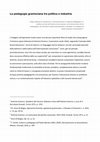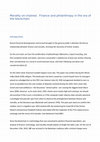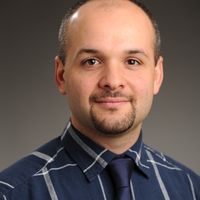Papers by Riccardo De Cristano

<<Ogni rapporto di «egemonia» è necessariamente un rapporto pedagogico e si verifica non solo nel... more <<Ogni rapporto di «egemonia» è necessariamente un rapporto pedagogico e si verifica non solo nell'interno di una nazione, tra le diverse forze che la compongono, ma nell'intero campo internazionale e mondiale, tra complessi di civiltà nazionali e continentali>> 1 L'indagine sull'egemonia risulta essere uno dei più importanti filoni di studio che compongono l'immensa opera letteraria di Antonio Gramsci. Il pensatore sardo infatti, seguendo l'esempio della Russia bolscevica 2 , cercò di tradurre «in linguaggio storico italiano» uno dei «principali postulati della dottrina e della tattica dell'Internazionale comunista» 3 . Lenin, già nel periodo prerivoluzionario, intuì che una classe sociale, per esercitare un ruolo egemonico, avrebbe dovuto dare una prova effettiva della sua superiorità 4 : per conquistare la supremazia nella società, oltre al dominio, ovvero alla forza bruta, i rivoluzionari avrebbero dovuto conquistare l'egemonia, ovvero la coercizione e persuasione, sulle altre classi sfruttate. Per le avanguardie bolsceviche risultava fondamentale trasformare la mentalità arretrata contadina, completamente aliena a concetti come la «lotta di classe» e rassegnata al proprio destino. La prassi rivoluzionaria comprende dunque pratiche pedagogiche e di conoscenza: per Gramsci l'educazione diventa un problema storico, e va contestualizzato rispetto all'industria capitalista e alle nascenti democrazie 5 .
Firth, Raymond, 1901-2002 & Association of Social Anthropologists of the Commonwealth & St. Anton... more Firth, Raymond, 1901-2002 & Association of Social Anthropologists of the Commonwealth & St. Antony's College (University of Oxford) & Firth, Raymond 1967, Themes in economic anthropology, Tavistock Publications, London, Sydney
PP. 149-174
Drafts by Riccardo De Cristano

Notwithstanding (or thank to) the general economic and environmental crisis, last year witnessed ... more Notwithstanding (or thank to) the general economic and environmental crisis, last year witnessed an unprecedented growth of financial markets: trillions of dollars flew towards financial products, with investors rewarding tech/virtual titles especially. In particular, 2021 has been “bullish” for the blockchain sector, which reached a multi-trillion dollars market cap and saw a vast array of projects flourishing, many of which were green finance: last year also saw values shift among crypto communities.
Many authorities have sanctioned this turn. For example, blockchain-based solutions were endorsed by COP26 and World Economic Forum to cope with climate change. Vitalik Buterin, the funder of Ethereum, donated a billion dollars to a COVID relief fund and became one of the main sponsors of Gitcoin. Kevin Owocki, its funder, wrote even a book/manifesto on new forms of green finance made possible by blockchain. This platform, through the narrative of “public goods”, shifted its core from listing open-source job ads to providing grants to develop Impact DAOs. “DAO” is an acronym for Decentralized Autonomous Organization, and despite an official definition doesn’t exist, it usually indicates online platforms whose users hold decisional and voting powers thanks to cryptographic tokens they “hold”; moreover, this term is often used in relation with web3, an ambiguous vocable used to indicate websites operated and improved by their users. Impact DAOs thus can be seen as online communities whose investments provide positive externalities, and in this paper, we will focus on those financing carbon offsetting.
Although critical studies on blockchain and the environment have been produced in recent years, the scientific literature focuses mainly on the former carbon footprint, leaving unexplored the green decentralized finance (DeFi).
This paper aims to fill this gap both on a macro and micro level, linking investors’ practices to the broader (neoliberal) socio-economic context, as wished by others (Büscher 2010) and, through the economic anthropology’s tropes of ‘technology’ (Mauss 2005; Hornborg 2016) and bureaucracy (Porter 2020; David Graeber 2015), explore which type of socio-political relation the blockchain “machine” actually enables. Through digital ethnographies of the communities involved in these projects, we will then identify the contradictions characterizing this new form of investment, showing how the notion of ‘transparency’, central in both blockchain and markets vocabulary, not only conflicts with the anonymity and the autonomy characterizing DAOs but also ends up obscuring and reinforcing global capitalism and its power relations, making blockchain a truly “anti-politics machine” (Ferguson 1990)
How finance, urbanism and education are linked and why this entanglement is fueling inequalities ... more How finance, urbanism and education are linked and why this entanglement is fueling inequalities in the US? In this brief document I try to connect the dots and show how current US' financial system is based on racial segregation
A brief insight on the links between climate change risk perception's and people's habitus.
A brief insight on the links between climate change risk perceptions
Dagli anni '80 in poi il mondo sembra aver passivamente accettato i dettami neoliberali. Ma le co... more Dagli anni '80 in poi il mondo sembra aver passivamente accettato i dettami neoliberali. Ma le cose stanno davvero così? A partire dal confronto coi padri dell'antropologia economica (Marcell Mauss, Karl Polanyi) mostreremo come la categoria dell'economico sia in realtà storicamente data e non assoluta. Se oggi ci sembra al contrario una categoria assoluta è perché – come già Benjamin notava – essa ha finito per assolvere alle stesse funzioni delle religioni; chiunque oggi voglia allora mettere in discussione l'egemonia neoliberale non può che confrontarsi con tutti quegli autori che da Marx in poi hanno notato come l'economia capitalistica non sia solo un modo di organizzare la produzione materiale all'interno della società, ma anche e soprattutto un modo per produrre (e riprodurre) una determinata sovrastruttura sociale.
Conference Presentations by Riccardo De Cristano

The Sam Bankman Fried saga gives us the opportunity to rethink how morality, technology and finan... more The Sam Bankman Fried saga gives us the opportunity to rethink how morality, technology and finance are deeply intertwined, thus representing the perfect example of a cyborg.
The rise of "crypto-philanthropy" can be seen as the embodiment of modern economic orthodoxy, since its proponents aim to find morals and values trough logic and mathematics, not so distant as Milton’s definition of economy as a "descriptive science" and they adopted into the design and the code of their applications the same highly mathematized and logic-based game-theoretic approach to economics; what makes this connection relevant is that cryptography, positive economics and modern computers they all stem from US military founded think tanks, while the implementation of positive economics into software design happened in the 80s: blockchain’s entrepreneurs fascination towards nonprofits would be then the last chapter of a novel started during WW2. These ambiguous links offer researchers the opportunity to overcome polarized accounts of contemporary financial markets and morality, but we will explore them rather than just expose or denounce them.
Elites’ morals and moralities then are contradictory themes: the contradiction at stake here is as old as capitalism itself, namely how social welfare can be pursued by the market, a system based upon self-interests; it should be noted that every hierarchic system needs a moral justification; it cannot rest upon only on violence. Anthropology sits in a privileged position to observe it. The neoclassical definition of economy as allocation of scarce resources is taken for granted in the design mechanism of these technologies [xviii], while anthropology has long been problematizing both the concept of scarcity (Harris 1959; Polanyi 1965) and technology itself (Hornborg 2014, 2011, 2001, 2016), so we can deconstruct their axioms and see which objective function is at play. The discipline already noticed how ambiguities can be found in social groups as a power structure is maintained, reproduced, and justified by a "gaze" floating around its origins (Godelier 1999). The reproduction of society as a whole is more important than any one of its singular components, and incongruencies that come up during this process are usually suppressed through (variably enforced) collective amnesias (Graeber 2001).
For this reason, asking ourselves if SBF or utilitarianism can be labelled as "moral" is not the main point; here it is sufficient to say that they were moral, in a broader sense: moral comes from the Latin mos, a term that contains both an ideal and a pragmatical aspect on an individual and societal level: a person is moral if he or she acts according to the mos. It can be translated both in an ethical sense as "proper way to act" and in a political sense as "tradition". SBF and utilitarianism were then unquestionably moral because they acted in line with the capitalistic tradition.
Moving from this definition, rather than see morality and finance as inevitably contraposed, we want to show how they are ontologically interlaced and how the development of computer technologies, and in particular of blockchains, plays a fundamental role in such intertwinement.
The paper will be structured in this way: we will first analyze SBF’s story, highlighting his unique relation with the philanthropic association Effective Altruism, then turn our gaze toward the latter and its utilitarian approach and how it is profoundly diffused among Silicon Valley entrepreneurs, especially those working with cryptocurrencies. The reason could be seen in the fact that Effective Altruism and other long-termism-inspired no-profits share, along with blockchain’s design, the utilitarian principles behind modern economic orthodoxy. Finally, this blending of economy, technology, and morality allows us to embrace the cyborg paradigm and frame web3 enterprises into the broader economic orthodoxy; we will end by reflecting on how classic anthropological themes can be fruitfully employed to study these new phenomena.

Monetary innovations are increasingly being geared towards, and used for, mitigating the ongoing ... more Monetary innovations are increasingly being geared towards, and used for, mitigating the ongoing climate crisis. Klima is a carbon-backed digital currency, operating on algorithms and run a the decentralized autonomous organization, DAO. In 2021, reports stated that the DAO had accumulated nine million tonnes of verified, tokenized carbon reductions or removals, valued at more than USD 100. In this paper, we probe how this carbon-backed digital currency is transforming carbon into assets, how this impacts the epistemology of prices and how DOA, the decentralized autonomous organization, is monetizing carbon by utilizing monetary innovations. We draw theoretical inspiration from STS, economic anthropology, sociology of money and related fields, where money is understood as an artifact, organizing socio-ecological relationships. While theoretical interventions into blockchain and non-fungible tokens have emerged over the past years, currencies specifically addressing the climate crisis have not received much attention. By assessing the currency of Klima, we will be able to contribute to the understanding of how money, as a key artifact in all societies across the globe, is currently being designed to mitigate the climate crisis. Our conclusions speak to the broader debates about green finance and how FinTech is appropriating ‘sustainability’ by transforming carbon into assets.
This paper is part of the "Workshop on Digitalisation and creation of alternative monetary and financial spaces" (9-10 June 2022, Université Grenoble Alpes, Saint Martin d’Hères, France)
Technology is seen as a neutral process by progressives and conservatives, its advancement is pra... more Technology is seen as a neutral process by progressives and conservatives, its advancement is praised as the key to solving any issues. However, the fourth industrial revolution is coupled with unmatched inequalities: this session aims to analyze how emerging technologies can produce injustices.











Uploads
Papers by Riccardo De Cristano
PP. 149-174
Drafts by Riccardo De Cristano
Many authorities have sanctioned this turn. For example, blockchain-based solutions were endorsed by COP26 and World Economic Forum to cope with climate change. Vitalik Buterin, the funder of Ethereum, donated a billion dollars to a COVID relief fund and became one of the main sponsors of Gitcoin. Kevin Owocki, its funder, wrote even a book/manifesto on new forms of green finance made possible by blockchain. This platform, through the narrative of “public goods”, shifted its core from listing open-source job ads to providing grants to develop Impact DAOs. “DAO” is an acronym for Decentralized Autonomous Organization, and despite an official definition doesn’t exist, it usually indicates online platforms whose users hold decisional and voting powers thanks to cryptographic tokens they “hold”; moreover, this term is often used in relation with web3, an ambiguous vocable used to indicate websites operated and improved by their users. Impact DAOs thus can be seen as online communities whose investments provide positive externalities, and in this paper, we will focus on those financing carbon offsetting.
Although critical studies on blockchain and the environment have been produced in recent years, the scientific literature focuses mainly on the former carbon footprint, leaving unexplored the green decentralized finance (DeFi).
This paper aims to fill this gap both on a macro and micro level, linking investors’ practices to the broader (neoliberal) socio-economic context, as wished by others (Büscher 2010) and, through the economic anthropology’s tropes of ‘technology’ (Mauss 2005; Hornborg 2016) and bureaucracy (Porter 2020; David Graeber 2015), explore which type of socio-political relation the blockchain “machine” actually enables. Through digital ethnographies of the communities involved in these projects, we will then identify the contradictions characterizing this new form of investment, showing how the notion of ‘transparency’, central in both blockchain and markets vocabulary, not only conflicts with the anonymity and the autonomy characterizing DAOs but also ends up obscuring and reinforcing global capitalism and its power relations, making blockchain a truly “anti-politics machine” (Ferguson 1990)
Conference Presentations by Riccardo De Cristano
The rise of "crypto-philanthropy" can be seen as the embodiment of modern economic orthodoxy, since its proponents aim to find morals and values trough logic and mathematics, not so distant as Milton’s definition of economy as a "descriptive science" and they adopted into the design and the code of their applications the same highly mathematized and logic-based game-theoretic approach to economics; what makes this connection relevant is that cryptography, positive economics and modern computers they all stem from US military founded think tanks, while the implementation of positive economics into software design happened in the 80s: blockchain’s entrepreneurs fascination towards nonprofits would be then the last chapter of a novel started during WW2. These ambiguous links offer researchers the opportunity to overcome polarized accounts of contemporary financial markets and morality, but we will explore them rather than just expose or denounce them.
Elites’ morals and moralities then are contradictory themes: the contradiction at stake here is as old as capitalism itself, namely how social welfare can be pursued by the market, a system based upon self-interests; it should be noted that every hierarchic system needs a moral justification; it cannot rest upon only on violence. Anthropology sits in a privileged position to observe it. The neoclassical definition of economy as allocation of scarce resources is taken for granted in the design mechanism of these technologies [xviii], while anthropology has long been problematizing both the concept of scarcity (Harris 1959; Polanyi 1965) and technology itself (Hornborg 2014, 2011, 2001, 2016), so we can deconstruct their axioms and see which objective function is at play. The discipline already noticed how ambiguities can be found in social groups as a power structure is maintained, reproduced, and justified by a "gaze" floating around its origins (Godelier 1999). The reproduction of society as a whole is more important than any one of its singular components, and incongruencies that come up during this process are usually suppressed through (variably enforced) collective amnesias (Graeber 2001).
For this reason, asking ourselves if SBF or utilitarianism can be labelled as "moral" is not the main point; here it is sufficient to say that they were moral, in a broader sense: moral comes from the Latin mos, a term that contains both an ideal and a pragmatical aspect on an individual and societal level: a person is moral if he or she acts according to the mos. It can be translated both in an ethical sense as "proper way to act" and in a political sense as "tradition". SBF and utilitarianism were then unquestionably moral because they acted in line with the capitalistic tradition.
Moving from this definition, rather than see morality and finance as inevitably contraposed, we want to show how they are ontologically interlaced and how the development of computer technologies, and in particular of blockchains, plays a fundamental role in such intertwinement.
The paper will be structured in this way: we will first analyze SBF’s story, highlighting his unique relation with the philanthropic association Effective Altruism, then turn our gaze toward the latter and its utilitarian approach and how it is profoundly diffused among Silicon Valley entrepreneurs, especially those working with cryptocurrencies. The reason could be seen in the fact that Effective Altruism and other long-termism-inspired no-profits share, along with blockchain’s design, the utilitarian principles behind modern economic orthodoxy. Finally, this blending of economy, technology, and morality allows us to embrace the cyborg paradigm and frame web3 enterprises into the broader economic orthodoxy; we will end by reflecting on how classic anthropological themes can be fruitfully employed to study these new phenomena.
This paper is part of the "Workshop on Digitalisation and creation of alternative monetary and financial spaces" (9-10 June 2022, Université Grenoble Alpes, Saint Martin d’Hères, France)
PP. 149-174
Many authorities have sanctioned this turn. For example, blockchain-based solutions were endorsed by COP26 and World Economic Forum to cope with climate change. Vitalik Buterin, the funder of Ethereum, donated a billion dollars to a COVID relief fund and became one of the main sponsors of Gitcoin. Kevin Owocki, its funder, wrote even a book/manifesto on new forms of green finance made possible by blockchain. This platform, through the narrative of “public goods”, shifted its core from listing open-source job ads to providing grants to develop Impact DAOs. “DAO” is an acronym for Decentralized Autonomous Organization, and despite an official definition doesn’t exist, it usually indicates online platforms whose users hold decisional and voting powers thanks to cryptographic tokens they “hold”; moreover, this term is often used in relation with web3, an ambiguous vocable used to indicate websites operated and improved by their users. Impact DAOs thus can be seen as online communities whose investments provide positive externalities, and in this paper, we will focus on those financing carbon offsetting.
Although critical studies on blockchain and the environment have been produced in recent years, the scientific literature focuses mainly on the former carbon footprint, leaving unexplored the green decentralized finance (DeFi).
This paper aims to fill this gap both on a macro and micro level, linking investors’ practices to the broader (neoliberal) socio-economic context, as wished by others (Büscher 2010) and, through the economic anthropology’s tropes of ‘technology’ (Mauss 2005; Hornborg 2016) and bureaucracy (Porter 2020; David Graeber 2015), explore which type of socio-political relation the blockchain “machine” actually enables. Through digital ethnographies of the communities involved in these projects, we will then identify the contradictions characterizing this new form of investment, showing how the notion of ‘transparency’, central in both blockchain and markets vocabulary, not only conflicts with the anonymity and the autonomy characterizing DAOs but also ends up obscuring and reinforcing global capitalism and its power relations, making blockchain a truly “anti-politics machine” (Ferguson 1990)
The rise of "crypto-philanthropy" can be seen as the embodiment of modern economic orthodoxy, since its proponents aim to find morals and values trough logic and mathematics, not so distant as Milton’s definition of economy as a "descriptive science" and they adopted into the design and the code of their applications the same highly mathematized and logic-based game-theoretic approach to economics; what makes this connection relevant is that cryptography, positive economics and modern computers they all stem from US military founded think tanks, while the implementation of positive economics into software design happened in the 80s: blockchain’s entrepreneurs fascination towards nonprofits would be then the last chapter of a novel started during WW2. These ambiguous links offer researchers the opportunity to overcome polarized accounts of contemporary financial markets and morality, but we will explore them rather than just expose or denounce them.
Elites’ morals and moralities then are contradictory themes: the contradiction at stake here is as old as capitalism itself, namely how social welfare can be pursued by the market, a system based upon self-interests; it should be noted that every hierarchic system needs a moral justification; it cannot rest upon only on violence. Anthropology sits in a privileged position to observe it. The neoclassical definition of economy as allocation of scarce resources is taken for granted in the design mechanism of these technologies [xviii], while anthropology has long been problematizing both the concept of scarcity (Harris 1959; Polanyi 1965) and technology itself (Hornborg 2014, 2011, 2001, 2016), so we can deconstruct their axioms and see which objective function is at play. The discipline already noticed how ambiguities can be found in social groups as a power structure is maintained, reproduced, and justified by a "gaze" floating around its origins (Godelier 1999). The reproduction of society as a whole is more important than any one of its singular components, and incongruencies that come up during this process are usually suppressed through (variably enforced) collective amnesias (Graeber 2001).
For this reason, asking ourselves if SBF or utilitarianism can be labelled as "moral" is not the main point; here it is sufficient to say that they were moral, in a broader sense: moral comes from the Latin mos, a term that contains both an ideal and a pragmatical aspect on an individual and societal level: a person is moral if he or she acts according to the mos. It can be translated both in an ethical sense as "proper way to act" and in a political sense as "tradition". SBF and utilitarianism were then unquestionably moral because they acted in line with the capitalistic tradition.
Moving from this definition, rather than see morality and finance as inevitably contraposed, we want to show how they are ontologically interlaced and how the development of computer technologies, and in particular of blockchains, plays a fundamental role in such intertwinement.
The paper will be structured in this way: we will first analyze SBF’s story, highlighting his unique relation with the philanthropic association Effective Altruism, then turn our gaze toward the latter and its utilitarian approach and how it is profoundly diffused among Silicon Valley entrepreneurs, especially those working with cryptocurrencies. The reason could be seen in the fact that Effective Altruism and other long-termism-inspired no-profits share, along with blockchain’s design, the utilitarian principles behind modern economic orthodoxy. Finally, this blending of economy, technology, and morality allows us to embrace the cyborg paradigm and frame web3 enterprises into the broader economic orthodoxy; we will end by reflecting on how classic anthropological themes can be fruitfully employed to study these new phenomena.
This paper is part of the "Workshop on Digitalisation and creation of alternative monetary and financial spaces" (9-10 June 2022, Université Grenoble Alpes, Saint Martin d’Hères, France)